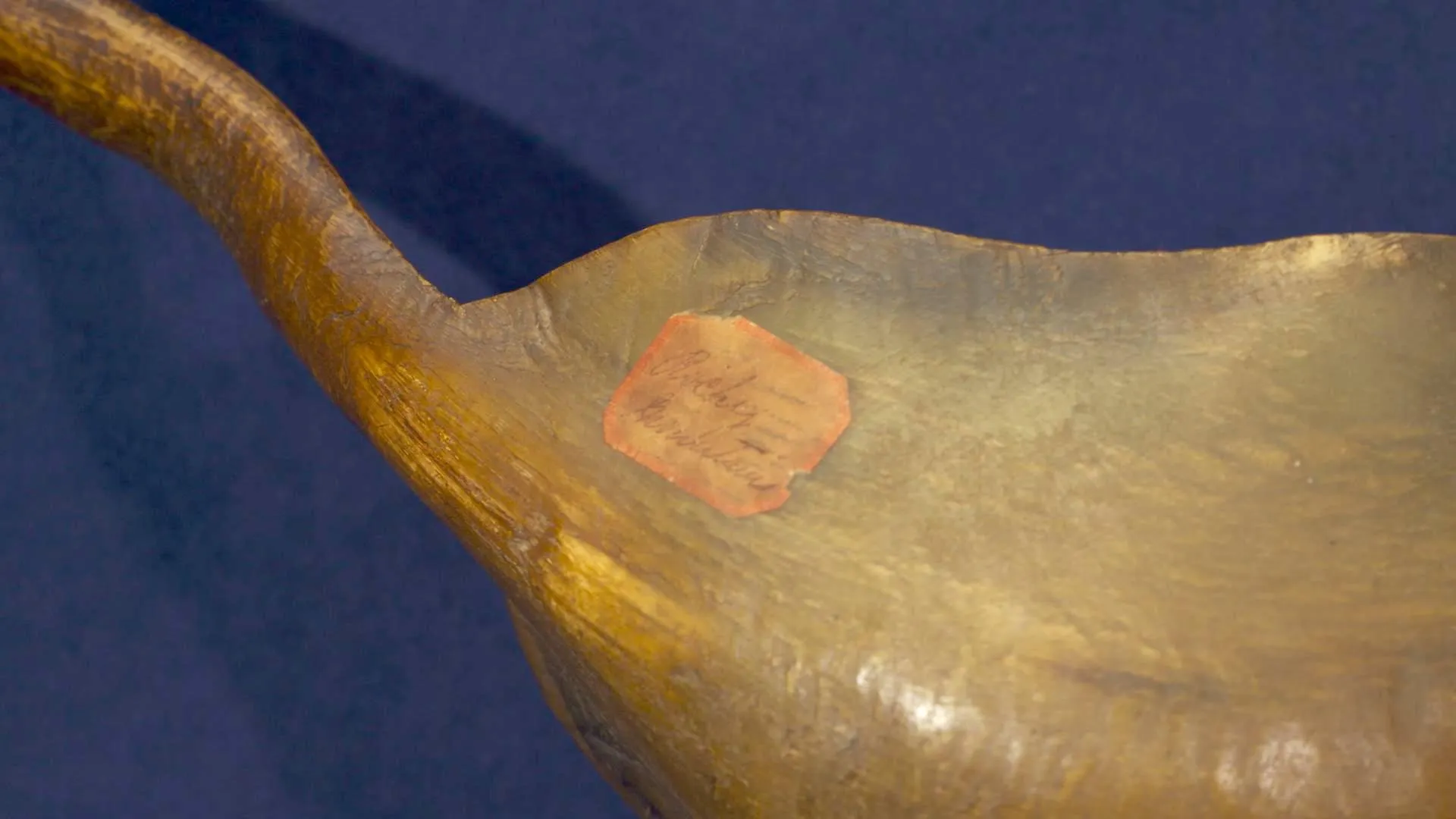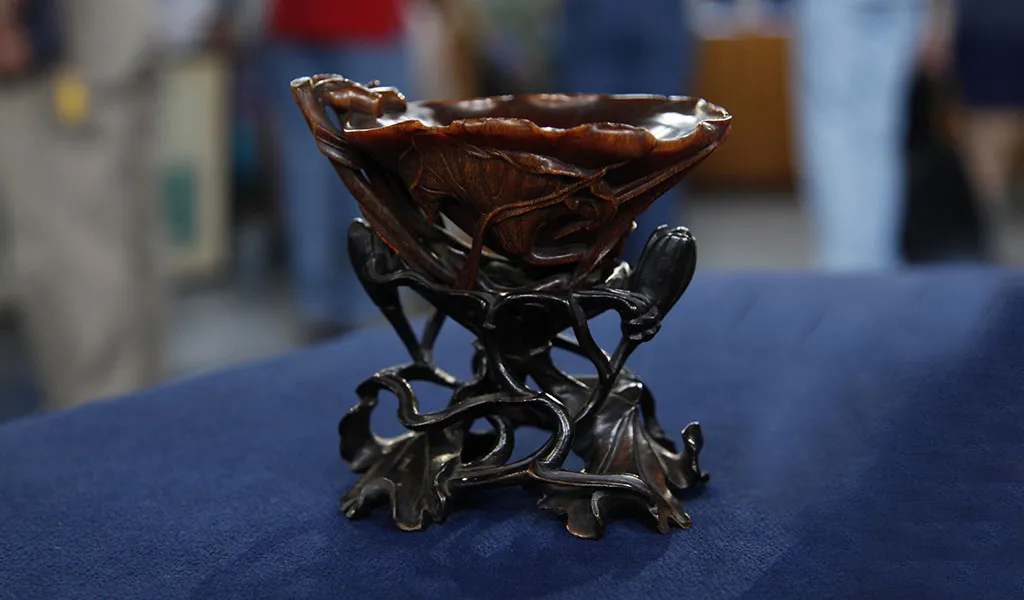Owning Animal-Derived Objects
More information about the laws and regulations that govern the owning and trading of artifacts derived from animals.

A large ladle crafted from the horn of a Rocky Mountain sheep circa 1850, appraised by Tribal Arts expert Bruce Shackelford during the August 2021 ANTIQUES ROADSHOW event in Bretton Woods, New Hampshire.
Feb 14, 2022
Originally published on: Jan 2, 2012
Over the past four decades, Doug, a resident of Tulsa, Oklahoma, acquired his collection of rhinoceros-horn libation cups at great personal cost, maxing out credit cards and curtailing vacations whenever a specimen caught his eye. But he wasn't pursuing a financial investment. Rather, he had a passion for the delicate craftsmanship that can turn a shapeless chunk of keratin into a nearly translucent, filigreed lotus blossom or ceremonial wine vessel. When Lark Mason, one of ROADSHOW's Asian Arts specialists, informed Doug that his $5,000 collection would now be worth $1 million to $1.5 million at auction, Doug was flabbergasted. It was the highest appraisal ever given in the history of the series.
Normally, the only risk you run in buying a poorly attested antique is making a bad investment. In the case of animal-derived objects, the risks can be far greater After the recording was initially publicized we heard from viewers who were concerned about the practice of collecting objects that come from endangered species. While the subject is both controversial and complicated, there are laws governing the owning and trading of animal materials that any informed collector should bear in mind.
Normally, the only risk you run in buying a poorly attested antique is making a bad investment. In the case of animal-derived objects, the risks can be far greater
As Mason pointed out during the appraisal, the high value was partially due to market fluctuations. But rhinoceros-horn libation cups are rare, and thus valuable, for another reason: Rhinoceroses are endangered, and international law prohibits the import and export of any rhinoceros-derived object. The cups in Doug's collection, dating to circa 1700, were crafted centuries before the international regulations were in place — and also before rhinos were endangered — so it was legitimate. But even in the case of bona fide antiques, collectors like Doug must be remarkably diligent if they are to avoid running afoul of the laws governing trade in animal materials.

One of Doug’s intricately carved rhino-horn cups, ca. 1700.
"All animal materials could have some form of regulation," says Michael McCullough, a New York lawyer who specializes in customs and trade issues. "Many people think it needs to be some exotic animal, but it doesn't." Scrimshaw, cat-pelt rugs, carved horns, and eagle-feather headdresses send up obvious red flags, but with three layers of international, federal, and state law, a lot of seemingly inoffensive material gets caught up in the net, too. The Migratory Bird Treaty Act alone prohibits the collection of the "parts, nests and eggs" of over 800 birds, many of which, like the American crow and the turkey vulture, are not remotely in danger of extinction.
Regulations vary so widely from species to species that it's almost impossible to make any generalizations. So how should the cautious collector proceed? McCullough says the first step in determining where an animal-derived object falls in the regulatory terrain is to answer the most basic question — What animal does it come from? — with scientific rigor.
"It's not enough to say, 'Oh, this looks like it could be bear fur or whalebone,'" he says. "The material needs to be identified scientifically, down to the level of species. If you have a piece of elephant ivory, for example, it's probably restricted in some way, but the exact regulations depend on which species of elephant you're dealing with."
Related Article: Overview of Current Ivory Law
Universities, zoos, and major museums are good places to start seeking expertise on a piece you may be uncertain about. Once the species has been identified, it becomes possible to begin navigating the regulatory labyrinth, either with the help of a lawyer or by contacting the Fish and Wildlife Service.
Is the animal protected under the Convention on International Trade of Endangered Species (CITES)? If so, does the federal government place any additional restrictions on trade and ownership? What exactly is prohibited? In the case of very old antiques, the ownership and sale of material from an endangered species is often allowed, so long as all the paperwork and permits are in order.
"But in other cases," says McCullough, "it can stay in your family but you can't sell it. You might not even be able to donate it to a museum."
McCullough says it's important to bear in mind that the regulations can have as much to do with paperwork as with the proscribed material itself. For example, he recently heard about a man who'd come to New York and bought some ivory that had been legally produced, exported, and sold. But when the man was boarding an international flight, he didn't declare the ivory on his customs form. He just put it in his pocket.
"He's been in jail for a couple of months now," says McCullough.
There can be no doubt that antiques containing animal materials are among the most legally fraught on the market. But the same principles that apply in establishing provenance for a Louis Quatorze commode are at work here, too: You have to demand that the seller provide you with documentation that tells you exactly what you are buying. Normally, the only risk you run in buying a poorly attested antique is making a bad investment. In this special case, the risks can be far greater, but as Doug's million-plus-dollar cup collection shows, so can the rewards.
Objects Derived from Non-Endangered Species
In some cases — such as a large ladle carved from a Rocky Mountain ram's horn a guest brought to the ROADSHOW event at Bretton Woods, New Hampshire, in August 2021 — the species of the animal material from which the artifact has been crafted is known and not subject to federal restriction.
Shackelford discussed the circa-1850 ladle (pictured at top) with its owner, Dawn, explaining that several Northern Plains Indian tribes are known to have made such objects from the sheep they hunted. Though regulated as game animals, Rocky Mountain sheep are not endangered and objects such as Dawn's ladle are still perfectly legal to own, buy, and sell. In addition, Shackelford points out, some animal-derived parts — such as American black and brown bear — are legal in some states and not others.
"As for Rocky Mountain sheep," Shackelford said by email a few months after his Bretton Woods appraisal, "you can go shoot one today in the states where they exist if you follow the laws — that is, have proper permits, and follow the state's hunting regulations. ... This spoon was probably purchased. There was a market in tribal items prior to the 1850s on the plains and the Rockies, and even by the early 1700s in northeastern America. They sold them door-to-door from the 1850s into the 20th century in the eastern Great Lakes area and upstate New York. These ladles were often brought back by travelers of all kinds as western souvenirs."
Objects Derived from Extinct Species
Provenance is extremely important in determining ownership rights of items deriving from extinct species like mammoth and mastodon. Owners of such objects must take into consideration the recently heightened and developed regulations surrounding provenance amongst experts and museums.
Lark Mason notes, “In general there exists today a heightened regulatory environment which has dramatically raised the importance of provenance for everything, not just endangered or extinct species. Where something comes from and the [supporting documentation] matter much more today than 20 years ago.”
In terms of buying, selling, and owning objects derived from extinct species, Mason offers the following advice and guidelines:
Trade in extinct species, usually as fossils, is often regulated based on the location of the discovery and ownership rights. Laws governing ownership apply to materials other than fossils, such as discoveries of an ancient burial site where ownership might rest or be controlled by the local or national governing authority.
Potential buyers should be aware that regulations regarding buried artifacts and extinct species differ (1) species by species (2) by the location and date of excavation as well as (3) ownership history, broadly described as provenance. All of these factors are important.
In the U.S., state law governs the sale of works within the boundaries of each individual state, but federal law governs the sale and transportation of works across state lines. International law regulates what can be transported and sold across international boundaries, but it should be noted that countries often have policies within their boundaries that are not consistent with U.S. or European Union practices.
Within the United States the superficial similarity of mammoth and mastodon tusks has led to some states such as New York, New Jersey, and California to enact limitations and prohibitions for the sale of these specimens, subject to local law, with allowances made for scientific, educational purposes and certain types of provenance.
It is the responsibility of U.S. buyers to know (1) the exact identity of the material being purchased, (2) what is and is not legal within the jurisdiction where an artifact crafted from ancient material has been sourced, (3) whether or not it can be transported outside of that jurisdiction, (4) and what documentation is required both within the source location and within the United States.
A commercial market for extinct species is dependent upon transparency and adherence to local, national, and international law, and the market is supported by trade organizations representing experts and dealers who specialize in these natural and man-made or human-worked artifacts.
The value of such an object depends on whether it legally can be sold, so it is important to know from whom you are purchasing the object. Check the vendor's professional background and membership in trade associations. Also take time to educate yourself on the local regulations where the object is to be shipped to, so that the dealer can provide details about what documentation is needed to comply with the jurisdiction where you are located. When you are considering the purchase or sale of one of these artifacts, work with professional and trusted individuals who are experts — just as you should with any other work of art.
Make sure you ask for records that document when and where the transaction occurred, along with the bill of sale. This will allow you to be prepared should your item ever transfer hands to someone else or to an institution.
If you have something that has passed down in your family, it is extremely important to retain any bills of sale; any old photographs that show the work in a specific location that can be dated by the presence of individuals who are in the photograph or dates on the back of the photograph; old appraisals; or other documents that mention the item. These records serve to establish provenance — a timeline that may help enable the object to be sold or donated in future and enjoyed by future generations.
Editor's Note 8.24.15: Doug's rhinoceros-horn libation cups were put up for auction in 2012. Two of the five cups were sold — one for $146,500 and one for $182,500.
Additional Resources
• Convention on International Trade in Endangered Species (CITES)
• Endangered Species Act (U.S. Code: Title 16, Ch. 35)
• Protected Species Parts (NOAA/U.S. Department of Commerce)





